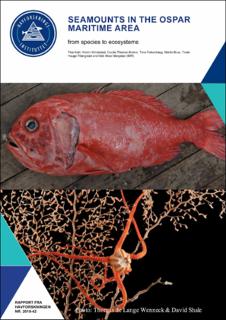| dc.description.abstract | This report was prepared by the Institute of Marine Research, Norway, for the Norwegian Environment Agency, as part of Norway´s contribution to OSPAR. The report summarizes the latest knowledge on species and habitats associated with seamounts in the OSPAR Regions I, IV and V. Knowledge was sought from published literature, reports and online marine data archives.
The global bathymetry model of Harris et al. (2014) predicts that 161 seamounts occurr within the OSPAR maritime area. Not all of these have been charted or studied, and the literature and bathymetry database review in this report resulted in a much shorter list of 100 seamounts or seamount-like features within the deep seas of OSPAR, i.e. regions I, IV and V. Published literature from the OSPAR area documented that there is knowledge of planktonic organisms for 11 seamounts, information on benthic species for 24 seamounts, and of fish from 16 seamounts. The best described component is the benthos with a total of 49 peer-reviewed papers.
The global knowledge of seamounts (and a few studies from the NE Atlantic) suggests that seamounts are inhabited by species from the regional species pool within the biogeographical zones they occur. At individual seamounts the structure of species assemblages and production patterns are variable over time and modified by factors such as the local and regional hydrography and circulation which are sometimes modified by the seamounts themselves. Other significant factors causing variability are the varying depths of slopes and summits in relation to the depth of the euphotic zone, the depth of summits relative to mesopelagic scattering layers, and presumably the distance from continents, islands and wider areas such banks and ridges. Furthermore, seamounts represent isolated shallows in the deep-sea and may have several important local and regional functions. However, within the OSPAR maritime area, few studies have produced more than descriptive data, hence a major shortage is the lack of quantitative information on species occurrences as well as studies measuring processes and documenting functions. The roles of seamounts at regional scales, e.g. as stepping stones for species across wider ocean areas, have only been incompletely studied.
Seamounts apparently constitute patches of suitable habitats for aggregating commercially valuable fish species that are relatively easy to locate and target, and if not properly controlled, to overexploit. This is known from the OSPAR region V, e.g. from historical depletion of orange roughy west of the British Isles and sharp declines of alfonsino aggregations on seamounts north of the Azores. Also, seamounts are features likely to have Vulnerable Marine Ecosystems (VMEs) (sensu FAO, 2009), primarily in the form of structure-forming coral and sponge aggregations. These require special protective action such as called for by the UN General Assembly and OSPAR, and accordingly several nations, the EU and the Northeast Atlantic Fisheries Commission (NEAFC) implemented measures to prevent further signficant adverse impacts from bottom fishing. Studies at many seamounts in OSPAR have shown that many summits have rich occurrence of VME indicator taxa and probably VMEs. Significant adverse impacts of past bottom fishing have been well documented in some slope and shelf habitats, but studies on seamounts have been scattered, and as yet there is not enough information to assess the overall status of VMEs on seamounts in Region I, IV and V. | en_US |
